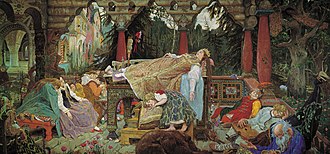
Back العلوم العصبية الخاصة بالنوم Arabic Neurociencia del sueño Spanish علوم اعصاب خواب Persian Neurobiologie du sommeil French Khoa học thần kinh giấc ngủ Vietnamese 睡眠神经科学 Chinese

The neuroscience of sleep is the study of the neuroscientific and physiological basis of the nature of sleep and its functions. Traditionally, sleep has been studied as part of psychology and medicine.[1] The study of sleep from a neuroscience perspective grew to prominence with advances in technology and the proliferation of neuroscience research from the second half of the twentieth century.
The importance of sleep is demonstrated by the fact that organisms daily spend hours of their time in sleep, and that sleep deprivation can have disastrous effects ultimately leading to death in animals.[2][3] For a phenomenon so important, the purposes and mechanisms of sleep are only partially understood, so much so that as recently as the late 1990s[4] it was quipped: "The only known function of sleep is to cure sleepiness".[5] However, the development of improved imaging techniques like EEG, PET and fMRI, along with high computational power have led to an increasingly greater understanding of the mechanisms underlying sleep.
The fundamental questions in the neuroscientific study of sleep are:
- What are the correlates of sleep i.e. what are the minimal set of events that could confirm that the organism is sleeping?
- How is sleep triggered and regulated by the brain and the nervous system?
- What happens in the brain during sleep?
- How can we understand sleep function based on physiological changes in the brain?
- What causes various sleep disorders and how can they be treated?[6]
Other areas of modern neuroscience sleep research include the evolution of sleep, sleep during development and aging, animal sleep, mechanism of effects of drugs on sleep, dreams and nightmares, and stages of arousal between sleep and wakefulness.[7]
- ^ "A brief history of sleep research".
- ^ "NCBI Sleep Guide". Archived from the original on 2007-01-10.
- ^ Cirelli C, Shaw PJ, Rechtschaffen A, Tononi G (September 1999). "No evidence of brain cell degeneration after long-term sleep deprivation in rats". Brain Research. 840 (1–2): 184–93. doi:10.1016/s0006-8993(99)01768-0. PMID 10517970. S2CID 592724.
- ^ Stickgold R, Valker MP (22 May 2010). The Neuroscience of Sleep. Academic Press. p. xiii. ISBN 9780123757227. Retrieved 18 July 2015.
- ^ Konnikova M (8 July 2015). "The Work We Do While We Sleep". The New Yorker. Retrieved 17 July 2015.
The Harvard sleep researcher Robert Stickgold has recalled his former collaborator J. Allan Hobson joking that the only known function of sleep is to cure sleepiness.
- ^ Kilduff TS, Lein ES, de la Iglesia H, Sakurai T, Fu YH, Shaw P (November 2008). "New developments in sleep research: molecular genetics, gene expression, and systems neurobiology". The Journal of Neuroscience. 28 (46): 11814–8. doi:10.1523/JNEUROSCI.3768-08.2008. PMC 2628168. PMID 19005045.
- ^ Stickgold R (2009). The Neuroscience of Sleep. Amsterdam: Boston : Academic Press/Elsevier. pp. 61–86. ISBN 9780123750730.